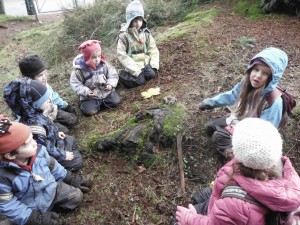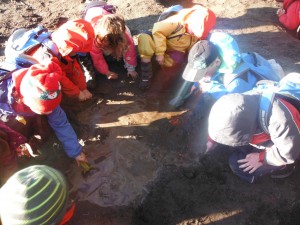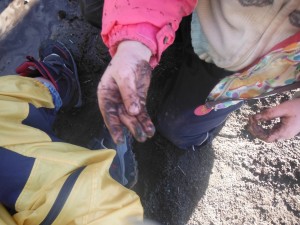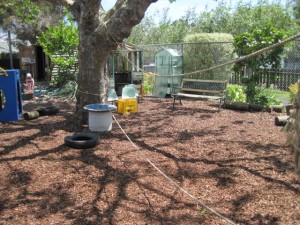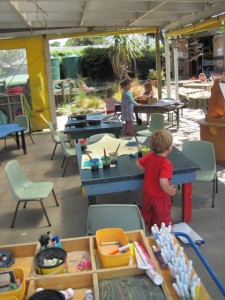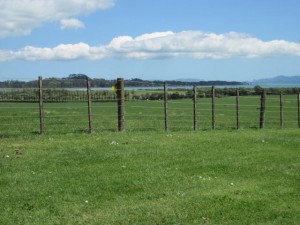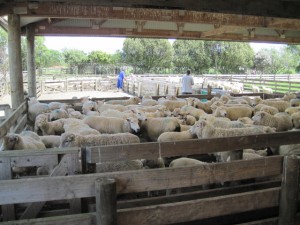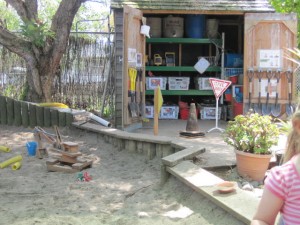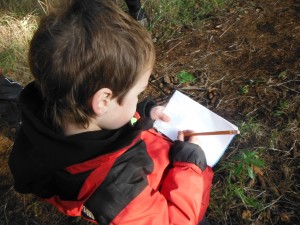For the most part, recently we have been learning about what animals do to survive in the colder temperatures, where they live and what they eat. Through discussions we discovered that some animals hibernate to stay alive during the winter months. We read some books (both fiction and non-fiction) about hibernation and then together we brainstormed about types of animals that hibernate. The children came up with: Bears, worms, frogs, and bats. We learnt that some are deep sleepers and others wake up to eat sometimes!
One day after reading a book about hibernation, we sent the children off with the suggestion that they could choose an animal to be and build a home to hibernate in. The children put themselves in groups and went off to find a spot for their shelter or den. Most children chose an animal, collected materials, found a location, and made a plan. Many were worms, beavers, bears, bats and then there were some wood bugs! Over the next few days structures started to emerge, plans were made, discussions had, ideas changed, groups changed, animals changed and most of all the children changed. Working together in teams there were children drawing plans on clip boards, collecting branches larger then themselves, gathering pinecones and leaves, building and of course there were the children supervising! First the structures looked like branches placed around them or a whole dug in the ground.
As the days passed Lisa and I offered some questions:
Will you fit in it?
Will you be safe from predators?
Will it be comfortable and warm?
Will you have enough food?
Will it last the whole winter?
Is it water proof? Does it need to be?
This is when the dens really took off. The children started to build their shelters higher, but soon realized with a roof they didn’t fit in. Working together one group moved all of their bark and branches over to the tree and leaned them up on against it. Five teams and about five dens emerged. There were elaborate bear dens with toilets, air fresheners, decorations and doors. There were dens that 3-4 children could fit in at a time, with roofs that were actually pretty water proof. There were wood bug houses with long tunnels with bedrooms and of course a castle. The branches that the children were moving were very big, heavy, and awkward. They dragged them across the site to their shelter. When they had finished building it, they made bathrooms and bedrooms in their shelter. For some reason, it was imperative that every shelter needed a bathroom!
Over the winter break the dens held up in the weather. When we come back after two weeks the children went right back into their same groups and shelters, and engaged right back into the same dialogue as though no time had passed. Many children collected branches, mud, and small sticks to “fill the cracks” so that they were more water proof (It was really rainy the first few days back).
Lisa and I were both amazed how fast the children got into groups and started this project. How much teamwork there was as well as how the play progressed and developed. The children were constantly engaged in negotiating and dialogue about what they were doing. Some children were the planners, others the collectors and some the builders. We noticed new friendships bloom and children who normally don’t play together successfully, work together to create something magical.
Children discovered that some branches work better than others, and that making it between and under fallen trees is a perfect dry place to build a den. They measured the branches and sorted the longer and shorter ones, and felt their weight differences. When they were building, we noticed the children figuring out which branches would fit where, and that the smaller ones were better for the door area. The climbed their dens to see if they were strong enough to last the winter. They hung cedar because it smelled good and helped them keep dry. They also discovered that bark made a good roof, and kept them the driest.
From this we will start to go deeper into shapes and measurement concepts as the dens have made some interesting shapes and the children were able to engage with many weight and measurement concepts. The environment has allowed us to start to explore 3D shapes by finding materials around us and then using them to create new shapes. Another very fun time at Nature Kindergarten!
